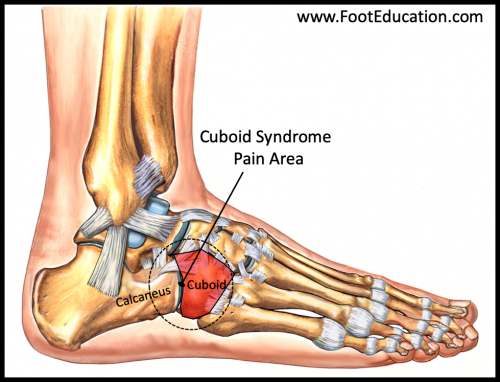Cuboid Syndrome
Summary
Cuboid syndrome causes pain on the outside of the foot. The pain comes from the disruption of the normal alignment of the cuboid bone (Figure 1) with the calcaneus (the heel bone). Cuboid syndrome can develop from a single event such as an ankle sprain or through repetitive impacts such as might be seen in a runner or dancer. Treatment includes physical therapy to mobilize the joint, comfort shoe wear, and soft-accommodative orthotics. In some instances, realignment of the cuboid by a medical professional may be necessary. Cuboid syndrome has a good prognosis with few complications; most individuals are able to return to full activity.
Figure 1: Common location of pain in cuboid syndrome
Clinical Presentation
Cuboid syndrome occurs when one or more of the ligaments between the cuboid and other bones of the foot (often the calcaneus) tears or stretches allowing the cuboid to change position slightly.
Patients who develop cuboid syndrome will often present with pain, discomfort, or weakness along the outside (lateral side) of the foot. The pain can be more widespread and may feel as if it originates from the outside of the ankle (referred pain). Individuals may limp or sway from side to side to avoid placing weight on the affected area. Onset of cuboid syndrome can occur suddenly or gradually though a sudden onset is more typical. Some patients may report a small “pop” on the outside of their midfoot. Ballet is the most common activity associated with cuboid syndrome. However, it also occurs in runners, or sports that require quick side to side movements.
Physical Exam
Mild swelling and bruising may be present on the outside and bottom of the patient’s midfoot with more severe swelling and tenderness suggesting a worse injury. Tenderness will be localized to the surface over and under the cuboid. Pain when pushing the foot to the outside while stabilizing the heel (midtarsal adduction test) also suggests a cuboid syndrome.
Imaging Studies
Imaging is typically normal, and the diagnosis is made through patient history and physical exam.
Treatment
Many instances of cuboid syndrome will resolve spontaneously. Gentle range of motion exercises can be helpful to realign the joints around the cuboid (ex. Calcaneocuboid joint). For patients with persistent symptoms of cuboid syndrome, a clinician may need to manipulate the cuboid back into place. Physical therapy may be prescribed to strengthen the foot and stretch muscles of the foot and calf. Supporting footwear and soft, over-the-counter orthotics may also be given to help maintain the cuboid in the appropriate position.
Recovery
The recovery from cuboid syndrome depends on a few factors such as how long the injury was present, if it occurred suddenly or over time, and if it was part of another injury such as an ankle sprain. Most people will feel relief from pain within a few days. When other injuries are present, healing can take up to several weeks.
June 6, 2020
